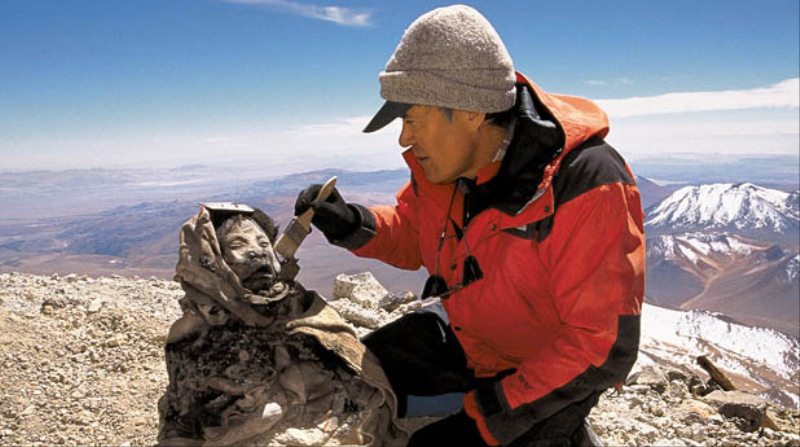The Man behind Juanita

|
The Man behind the
Mummy
By Mary Margaret Overbey
When the five hundred year old Incan mummy known as the "Ampato Ice Maiden" or "Juanita" made her first voyage to the US, American anthropologist Johan Reinhard, with his assistant Miguel Zarate, had discovered the mummy at 20,700 feet on Mount Ampato in Peru in September 1995. The first frozen Incan female sacrifice to be found, Juanita immediately captured the world’s interest. Approximately thirteen years old when she died and remarkably well preserved, she offered a glimpse into the life and beliefs of the Inca. The discovery of Juanita was cited as one of the top nineteen scientific discoveries of 1995 by Time (December 25, 1995/January 1, 1996, p 161) and one of the top hundred science stories of 1995 by Discover (January 1996, p 20). Juanita made the cover of Newsweek (Latin American issue), the New York Times and newspapers and magazines around the world. The find catapulted Reinhard to scientific stardom. From the first announcement in 1995, Reinhard was overwhelmed by media wanting to know more about the Inca and mountain sacrifices of young children. Reinhard was seen by many as cultural broker for a population that couldn’t speak for itself, the Inca represented by their mountain sacrifices.
 Story behind the Story: For many anthropologists, Reinhard is the story behind the story. Dedicated to "doing anthropology", Reinhard has combined his love of anthropology and mountain climbing to conduct high-altitude archaeology fieldwork in the Andes, where he has worked the last seventeen years. Raised in New Lenox, Illinois, Reinhard was first exposed to "culture" at age sixteen and seventeen, when he worked for two summers on a railroad line crew throughout the Midwest. There, he experienced "a shock to find such a radically different culture" among the numerous southern workers. He discovered cultural anthropology at the University of Arizona and was "fascinated studying how other people see the world". Reinhard completed his Ph.D. at the University of Vienna, Austria. Reinhard’s original fieldwork focused on culture change in the midhill and jungle area of the Himalayas. He took up mountain climbing and began to examine some of the twenty hidden lands of Tibetan Buddhism, all protected by mountain deities. While visiting Chile in 1980, Reinhard read an article on Incan sites that had been found up to 22,000 feet in the Andes and decided to investigate. For him, the research combines theory and methods associated with cultural anthropology, archaeology, ecology and ethnohistory, to better understand the sites, Incan culture and contemporary Andean beliefs.
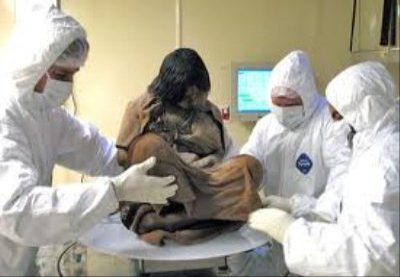 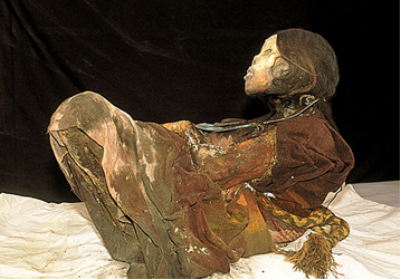
Resident scholar at
the Mountain Institute in West Virginia and research associate at the Field
Museum of Natural History, Chicago, Reinhard spends most of his time in the
field. He has calculated that in one period of 17 years, he did not stay in one
place for more than three months. Although his field research is supported in
part by grants, he has never had a grant that gave him a salary. He received the
Rolex Award in 1987 - a gift of $35,000 given every three years to five
outstanding people - and was able to live on this for three years. "I’m in
anthropology because I enjoy ‘doing anthropology’, being in the field learning,"
he states. In January 1997, Reinhard began a six month stint as the National
Geographic Society’s Explorer in Residence, a job that will allow him to
continue his research. Reinhard’s research
is risky, requiring mountaineering skills, physical stamina and knowledge of
weather changes. He has nearly lost his life on numerous occasions. Not
surprisingly, there are few high-altitude archaeologists despite the many sites
to explore. Finding Juanita: Although he has recovered many mummies throughout his career, Juanita has been Reinhard’s most outstanding discovery. The site was exposed after a nearby volcanic eruption caused the snowcap on Mount Ampato to melt. The ceremonial platform had collapsed, and Juanita and ceremonial offerings has fallen into the mountain’s crater. Reinhard and Zarate spotted the colored feathers of Juanita’s ceremonial statues on the summit ridge and climbed into the crater to retrieve her. The descent and return to Arequipa was arduous, with Reinhard and Zarate racing to get Juanita into a freezer at Catholic U in Arequipa before she thawed. Although her face was dried due to sun exposure, Juanita was almost perfectly frozen, as her ancestors intended her to remain.
 Austrians who had
studied the Bronze Age "Iceman" and other experts arrived in Peru to consult
with Reinhard, Peruvian archaeologists and project codirector José Antonio
Chavez, Peruvian researchers and government officials on research options. They
recommended that 3-D stereolithic computer topography (CT) scans be done. Johns
Hopkins Medical Institution was one of the few places in the world to offer this
type of CT scanning. Maintaining a frozen
mummy over time requires special freezers. Carrier Corporation of the US,
offered to make two computerized freezer units for the project and donate them
to Peru. Carrier, however, needed to work with the mummy and the freezer unit.
Pressure was building to have the mummy visible for conservation specialists.
Some Peruvians were especially interested in an exhibit of the mummy to draw
worldwide attention to Peru, Arequipa and the Colca Canyon where Juanita was
found. An exhibit would also help raise funds to maintain the mummy in Peru. A
request was made through Peru’s National Institute of Culture to allow Juanita
to come to the US for research and Johns Hopkins, review by Carrier Corporation
and exhibition by the National Geographic Society. The Peruvian national
Institute of Culture sought the counsel of legal, medical, physical
anthropological and archaeological commissions on the petition. All commissions
approved the request, and Peruvian president Alberto Fujimori agreed to the
trip. NAGPRA Concerns: The proposed visit and exhibit raised initial concerns related to the US’s Native American Graves Protection and Repatriation Act (NAGPRA), particularly with regards to the ethics of displaying publicly a deceased Native American. Cognizant of NAGPRA, legislation and sensitivity associated with such an exhibition, Reinhard and National Geographic’s George Stuart contacted Native American representatives regarding Native American reaction to the exposition. While some acknowledged that they didn’t like the idea, they would honor the wishes of the people in the area where Juanita was found. Unlike Native Americans in the US, most indigenous Andeans regard the body as a material remain without spirit and do not object to public display of Juanita. People in the village of Cabanaconde closest to Juanita’s burial site had already displayed a mummy in the local high school. Andean beliefs regarding the discovery of mountain artifacts also differ from those of US Native Americans. Among indigenous Andeans and ancestral Inca, the mountains are viewed as gods. Andean people revere and make offerings to the mountain god, who in turn give gifts to the people. Anything "found" on the mountain is perceived by many to be a gift from the mountain god to the discoverer. Knowing that every culture has ways to deal with the dead, Reinhard saw the heart of NAGPRA as respecting the beliefs of the people most closely related to the deceased. To do otherwise would be "reverse cultural imperialism," in his view. Reinhard regarded what few complaints he heard as the voice of a microminority who did not know the facts of the case.
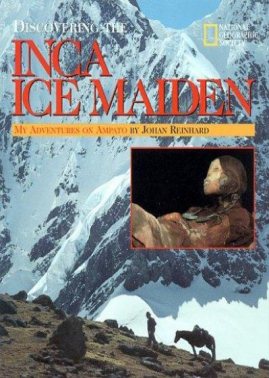 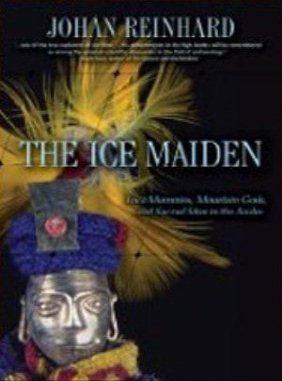 Juanita Goes to Washington: Media coverage of Juanita’s visit to Washington, DC was comparable to that accorded a world-renowned, jet infrequent visitor like the Pope. No one felt the crush of the press more than Reinhard, who viewed it as "another anthropological experience" and an opportunity to explain mountain sacrifices and what they tell us about Incan culture. One day, Reinhard began to shave at 7:30 am and didn’t finish until noon because of constant telephone interruptions by the press. CT scans at Johns Hopkins revealed that Juanita died from a blow to the right temple. Other findings, reported by Reinhard (January 1997 National Geographic, pp. 36-43), revealed that her last meal of vegetables was eaten within 6-8 hours of death. Carbon-14 dates confirmed Juanita’s age, 530+50 years. Research continues to determine Juanita’s genetic relatedness through microhondrial DNA taken from muscle tissue. Nearly 100,000 people visited Juanita during the nearly month long exhibit at the National Geographic Society. First lady Hillary Rodham Clinton and Fujimori attended the exhibit opening, in addition to about a dozen people from Cabanaconde. No complaints about display of the Ice Maiden from those who visited her were received. "That speaks volumes," reports Reinhard. What concerned and surprised Reinhard about the exhibit was the reaction of children to Juanita, "Children seemed fascinated. The number of children who saw her and felt a kinship to her was surprising. She really was an emissary through time." The Ice Maiden kindled children’s curiosity in the past and Incan culture. Thousands of children and schools regularly visit Juanita on National Geographic Society’s Web site. Juanita’s Future:
Juanita returned to
Peru after the exhibit in June 1996 and went on short-term exhibit in Peru where
she has been visited by over 100,000 Peruvians. Reinhard wants to
ensure the long-term conservation and preservation of the Ice Maiden in Peru.
This is in keeping with the future the Inca themselves had planned for her. To
return her to Mount Ampato is not an option because plunder and destruction
would be certain. Currently, dynamiting to expose Incan sites by looters is
rampant in the Andes. "Whatever we do, we should err on the side of conservation
and preservation. It’s necessary to understand that it’s impossible to guard
these sites and only a matter of time before they will be looted. The idea of
not touching sites or reinterring the mummies is to subject them to certain
destruction. Once an artifact is destroyed, it is gone forever. That was not
what the Incas wanted or Peruvians want," states Reinhard. Reinhard continues to
work on his finding and will begin writing a book. He will return to Peru to
continue collaborative research and training of future high altitude
archaeologists with Chavez. He views the experience with Juanita as worthwhile.
"One of the things I’ve seen come out of this is the intense public interest,
particularly among young people. This interest in the Ice Maiden has the
potential to be used in a positive way to increase people’s understanding of
other cultures, anthropology and what being human is all about," says
Reinhard. Perhaps that was the intent of Mount Ampato’s gift to Reinhard and the world: To enable a past culture to speak to the present. We visited the Museo Santuarios Andinos de la Universidad Catolica de Santa Maria in Arequipa to see Juanita. On arrival we saw a video of her discovery and found her discoverer to be a noble man with good intentions. We were shown by a guide all the artifacts that had been found with her, the shawl, the belt that would have been made by her mother, her shoes. Then we were shown into the room that held her suspended in time (and ice air), all very moving and an opportunity not to be missed in this city.
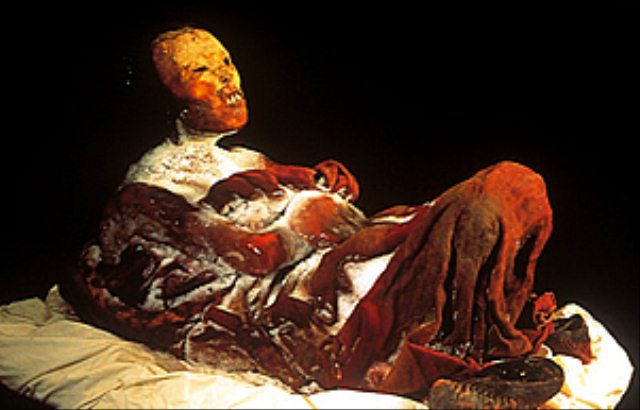
ALL IN ALL ABSOLUTELY FASCINATING STUNNING TO SEE BUT SURPRISINGLY SMALL |
